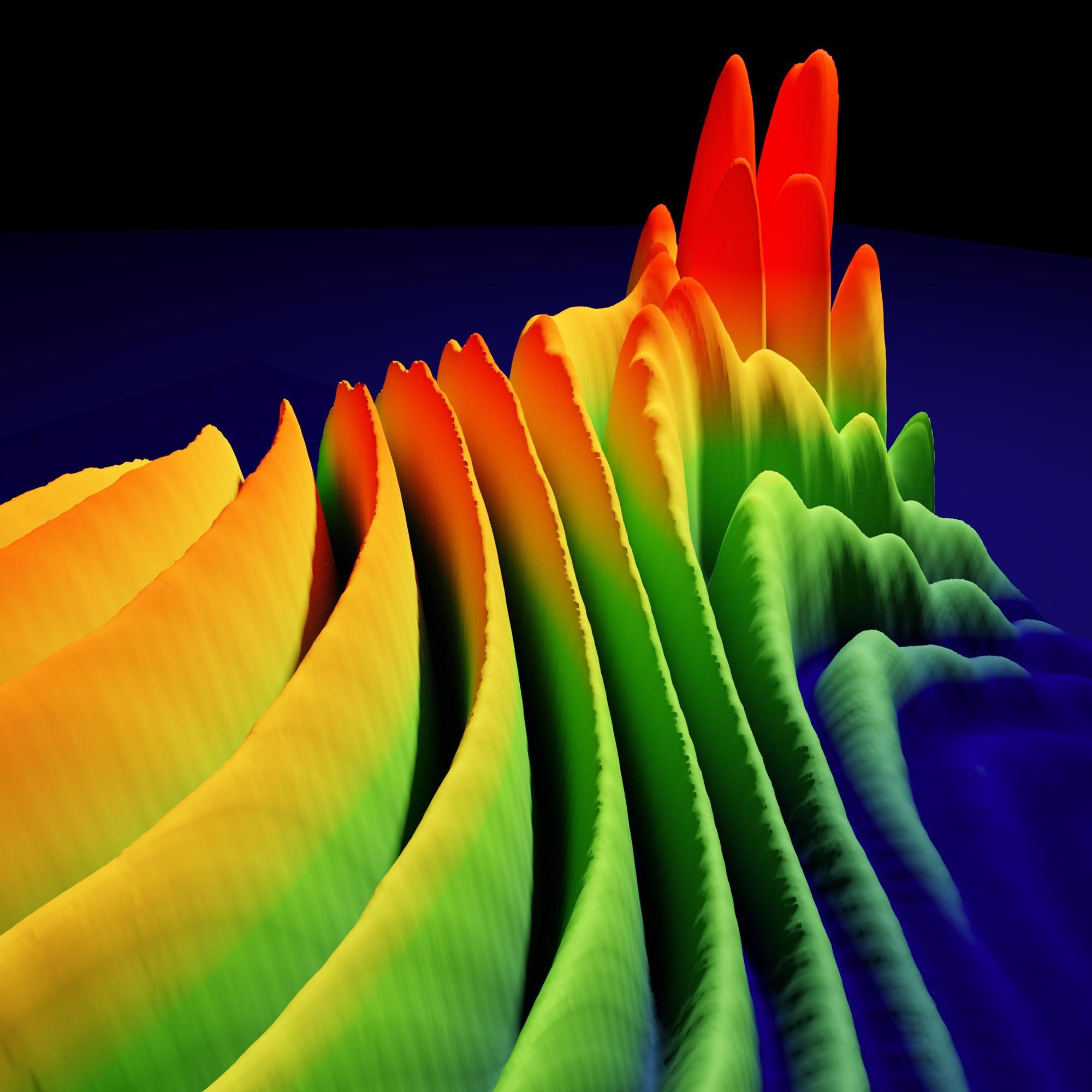The technological significance of ultrashort flashes of light lasting below a quadrillionth of a second is rapidly increasing. In laser sources, groups and pairs of light flashes can be developed instead of separate flashes. Akin to the chemically bonded atoms in a molecule, they are joined with each other and their short temporal intervals can hold extraordinary stability.
 Ultrashort solitons superimpose and produce spectral interference patterns: real-time spectroscopy resolves their fast dynamics and tracks the switching of soliton molecules in a femtosecond fiber laser. The image shows successive experimental spectra recorded during a switching process. Image Credit: Moritz B. Heindl
Ultrashort solitons superimpose and produce spectral interference patterns: real-time spectroscopy resolves their fast dynamics and tracks the switching of soliton molecules in a femtosecond fiber laser. The image shows successive experimental spectra recorded during a switching process. Image Credit: Moritz B. Heindl
Scientists at the Universities of Bayreuth and Constance have recently discovered a cause for the unwavering coupling of ultrashort light flashes and learned a method to regulate their spacing both rapidly and precisely. They describe their research findings in the journal Optica.
Light flashes shorter than a quadrillionth of a second are also known as femtosecond pulses. Currently, they are employed for investigating energy materials, as precision scalpels in medicine, or in the 3D manufacturing of parts.
These flashes in lasers are formed as solitons that can be defined as stable packets of light waves. The discovery about their coupling that has presently been published was acquired on a laser resonator. This comprises a ring of glass fibers that permits the solitons to flow limitlessly.
In those systems, one frequently sees coupled femtosecond flashes, so-called soliton molecules. By employing high-resolution real-time spectroscopy, the researchers were successful in trailing the dynamics of two coupled flashes instantaneously during several hundreds of thousands of orbits.
Based on this data, the researchers could demonstrate that it is optical reflections within the laser resonator that couple the separate solitons in space and time. The binding distances could be projected on the basis of transit time differences within the resonator and could finally be precisely adjusted by shifting optical elements.
Furthermore, the new research demonstrates how the bond between two flashes could rapidly be loosened and a new bond formed. It is currently possible, for example, to precisely switch back and forth between light flashes that happen in pairs and possess diverse temporal intervals.
Based on our research results, it is now possible to switch soliton molecules at the push of a button. This opens up new perspectives for the technical application of femtosecond pulses, especially in spectroscopy and materials processing.
Luca Nimmesgern B.Sc., Study First Author and Physics Master's Student, University of Bayreuth
The results acquired at the laser resonator can be transferred to a range of ultrashort pulse laser sources. Accordingly, it is possible to produce coupled light flashes in other laser systems and change their distances easily.
Since the first reports of pulse pairs in fibre lasers more than 20 years ago, different explanations have been proposed for the stability of soliton molecules in lasers. The usual models have been contradicted by numerous observations, but are still used today.
Georg Herink, Research Coordinator and Junior Professor for Ultrafast Dynamics, University of Bayreuth
“Our new study now offers a precise explanation compatible with the measured data for the first time. In a way, it provides a piece of the puzzle that makes a multitude of earlier data understandable. Now, complex laser physics can be used specifically to generate soliton sequences at high speed,” Herink added.
The research group led by Dr. Alfred Leitenstorfer from the University of Konstanz has been involved in the creation of fiber lasers as a tool for spectroscopy for years.
Based on our new findings, we can look forward to the realisation of versatile technological applications.
Dr. Alfred Leitenstorfer, Study Co-author and Professor, University of Konstanz
In recent times, a DFG research project at the University of Bayreuth began with the aim of comprehending the interactions between ultrashort solitons in laser sources exhaustively and making them practical for laser applications in the future.
Journal Reference:
Nimmesgern, L., et al. (2021) Soliton molecules in femtosecond fiber lasers: universal binding mechanism and direct electronic control. Optica. doi.org/10.1364/OPTICA.439905.